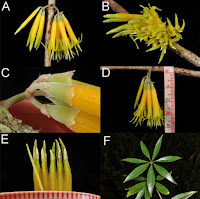 |
| Oreotrochilus cyanolaemus
Sornoza-Molina, Freile, Nilsson, Krabbe & Bonaccorso, 2018
at the type locality, El Oro province, southwest Ecuador.
DOI: 10.1642/AUK-18-58.1
Illustration: Paul Greenfield
|
ABSTRACT
We describe a new species of the genus Oreotrochilus from the southwestern Andes of Ecuador. The new species is most similar in adult male plumage to O. stolzmanni and O. chimborazo. However, male and female show unique combinations of plumage characters that are likely to act as social signals. Phylogenetic analyses based on mitochondrial DNA indicate that this new taxon is closely related to O. stolzmanni and O. melanogaster, whereas genetic distances and preliminary comparisons of vocalizations suggest a sister relationship with O. stolzmanni. The geographic distribution of the new species seems to be restricted to cordillera Chilla-Tioloma-Fierro Urcu, in the southwestern highlands of Ecuador, an area historically poorly explored by ornithologists. Thus, based on its restricted distribution, apparently low population size, and lack of protection of its habitat, we evaluate it as critically endangered.
Keywords: Andes, Oreotrochilus, southwest Ecuador, sp. nov., Trochilidae
Oreotrochilus cyanolaemus sp. nov.
Blue-throated Hillstar / Estrella de Garganta Azul (Spanish)
Holotype: Study skin MECN-9614; adult male (testes 3.7 × 3 mm, no bursa fabricii), 1 km W of Cerro de Arcos, El Oro province; 3,648 m a.s.l.; collected on May 23, 2017, by F. Sornoza-Molina, J. Freile, and J. Nilsson; prepared by F. Sornoza-Molina; field catalogue number AVES-0319; GenBank accession number MH543324.
Diagnosis: The following combination of characters are diagnostic for male Oreotrochilus cyanolaemus from other Oreotrochilus species (Figure 4): (1) ultramarine blue throat, (2) emerald green head with blue green terminal tips, (3) emerald green upperparts with blue green terminal tips, (4) narrow and faint emerald green terminal tips to throat feathers. Females are distinguished by the following characters: (1) dusky grayish chin and upper throat contrasting with whitish lower throat, (2) emerald green head with blue green terminal tips, (3) emerald green upperparts with faint blue green shine, especially on the rump.
....
Etymology: The compound specific epithet is a Latinized Greek noun in apposition (ICZN 1999) and describes the most distinctive character of the new species: its deep to ultramarine blue (kuanos) throat patch or gorget (laimos = throat).
Francisco Sornoza-Molina, Juan F. Freile, Jonas Nilsson, Niels Krabbe and Elisa Bonaccorso. 2018. A Striking, Critically Endangered, New Species of Hillstar (Trochilidae: Oreotrochilus) from the southwestern Andes of Ecuador [Una sorprendente y críticamente amenazada especie nueva de estrella (Trochilidae: Oreotrochilus) de los Andes suroccidentales de Ecuador]. The Auk. 135(4);1146-1171. DOI: 10.1642/AUK-18-58.1
Newly discovered hummingbird species already critically endangered phys.org/news/2018-09-newly-hummingbird-species-critically-endangered.html via @physorg_com
Una sorprendente y críticamente amenazada especie nueva de estrella (Trochilidae: Oreotrochilus) de los Andes suroccidentales de Ecuador
RESUMEN: Describimos una nueva especie del género Oreotrochilus de los Andes suroccidentales de Ecuador. Esta nueva especie se asemeja en plumaje de macho adulto a O. stolzmanni y O. chimborazo. Sin embargo, macho y hembra muestran una combinación única de características de plumaje que probablemente actúan como señales sociales. Los análisis filogenéticos basados en ADN mitocondrial muestran que la nueva especie está más emparentada con O. stolzmanni y O. melanogaster, mientras que las distancias genéticas y un análisis preliminar de vocalizaciones sugieren que es especie hermana de O. stolzmanni. La distribución geográfica de esta nueva especie está al parecer confinada a las cordilleras de Chilla-Tioloma-Fierro Urcu, en los Andes del suroeste de Ecuador, en un área históricamente poco explorada desde el punto de vista ornitológico. En base a su distribución muy restringida, aparente bajo tamaño poblacional y la falta de protección en sus hábitats, la calificamos como críticamente amenazada.
Palabras clave: Oreotrochilus, sp. nov., Trochilidae, Andes, suroccidente de Ecuador
















































